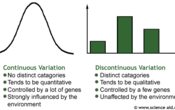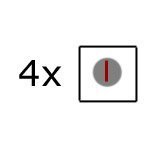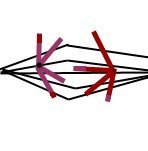Science Aid High School Biology: Variation and Meiosis
Edited by Jamie (ScienceAid Editor), Taylor (ScienceAid Editor)
Variation
As you are most likely aware we are not all the same and have different physical characteristics. This variation is caused by a combination of genetic and environmental factors. Variation tends to come in two types:
It is continuous variation that tends to be more common, with many things including height, hair color and intelligence - all being spread out in this way because we have so many genes that all influence one characteristic. One of the ways that variation is caused is by meiosis.
Meiosis
Meiosis is the type of cell division that takes place in gametes (sex cells) to ensure all cells are haploid (n) and that there is genetic variation. The table below outlines some of the key points of meiosis.
| Process | Diagram | Explanation |
|---|---|---|
| Pairing by homologous chromosomes. | Homologous chromosomes are ones that have coding for the same genes (not necessarily the same characteristics though). They line up beside each other to form a bivalent. This means that when they divide, each cell will have all the necessary genes and nothing will be missing. | |
| Chiasma formation and exchange between chromatids. | This is also known as crossing over. What happens, is the homologous chromosomes join at a chiasma (the point where they overlap) so when they pull apart, they swap bits of gene, thus providing variation. | |
| Separation of chromatids | Spindle fibres from the centriole pull the chromatids apart to opposite poles of the cell. | |
| Production of haploid cells | The cell divides in to two and then those halves divide again to make 4 cells, each now has a haploid number of chromosomes (in humans this is 23). Two will contain a paternal chromosome (inherited from father) and two from the mother. |
Independent assortment provides genetic variation in Meiosis. When the bivalent is formed, there is no particular order that the two chromosomes adhere to, therefore in organisms where there is more than one pair of chromosomes, there are a lot of different arrangements of maternal and paternal chromosomes.
Another way that variation is maintained is by random fertilization this means that any egg can combine with any sperm (in humans) so that there is even more combination possibilities.
Referencing this Article
If you need to reference this article in your work, you can copy-paste the following depending on your required format:
APA (American Psychological Association)
Science Aid High School Biology: Variation and Meiosis. (2017). In ScienceAid. Retrieved Apr 26, 2024, from https://scienceaid.net/biology/genetics/variation.html
MLA (Modern Language Association) "Science Aid High School Biology: Variation and Meiosis." ScienceAid, scienceaid.net/biology/genetics/variation.html Accessed 26 Apr 2024.
Chicago / Turabian ScienceAid.net. "Science Aid High School Biology: Variation and Meiosis." Accessed Apr 26, 2024. https://scienceaid.net/biology/genetics/variation.html.
If you have problems with any of the steps in this article, please ask a question for more help, or post in the comments section below.
Comments
Article Info
Categories : Genetics
Recent edits by: Jamie (ScienceAid Editor)







